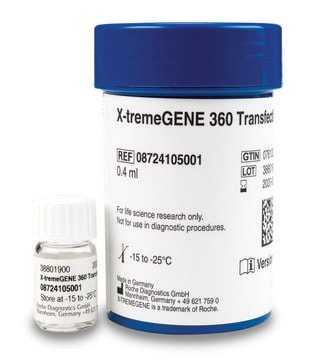SCC109
AC16 Human Cardiomyocyte Cell Line
AC16 Human Cardiomyocytes can be serially passaged and can differentiate when cultured in mitogen-free medium. The cells may be used to study developmental regulation of cardiomyocytes.
Synonym(s):
AC16 Ventricular Cardiomyocyte Cell Line
Sign Into View Organizational & Contract Pricing
All Photos(2)
About This Item
UNSPSC Code:
41106514
eCl@ss:
32011203
Recommended Products
biological source
human
Quality Level
technique(s)
cell culture | mammalian: suitable
shipped in
dry ice
Related Categories
General description
AC16 Human Cardiomyocyte Cell Line is a proliferating cell line that was derived from the fusion of primary cells from adult human ventricular heart tissues with SV40 transformed, uridine auxotroph human fibroblasts, devoid of mitochondrial DNA . After selection in uridine-free medium to remove unfused fibroblasts, the resulting fused cells were further subcloned and subsequently screened for the presence of SV40 large T-ag, β-myosin heavy chain (βMHC) and connexin-43 (CX-43) .
AC16 cells are proliferating and differentiation of the cells may be controlled by altering culture conditions and by silencing the expression of SV40 T-Ag . The cells can be used to study cardiac gene expression and function, during normal development and in pathological conditions at the cellular, organellar and molecular levels.
AC16 cells are proliferating and differentiation of the cells may be controlled by altering culture conditions and by silencing the expression of SV40 T-Ag . The cells can be used to study cardiac gene expression and function, during normal development and in pathological conditions at the cellular, organellar and molecular levels.
Cell Line Description
Cardiomyocyte Cells
Application
Research Category
Cardiac
Cardiovascular Disease
Toxicity
Cardiac
Cardiovascular Disease
Toxicity
This product is available for sale to academic institutions or not-for-profit entities for research use. For information on commercial licensing please contact licensing@emdmillipore.com.
Quality
• Each vial contains ≥ 1X106 viable cells.
• Cells are tested negative for HPV-16, HPV-18, Hepatitis A, B, C, and HIV-1 & 2 viruses by PCR.
• Cells are negative for mycoplasma contamination.
• Each lot of cells is genotyped by STR analysis to verify the unique identity of the cell line.
• Cells are tested negative for HPV-16, HPV-18, Hepatitis A, B, C, and HIV-1 & 2 viruses by PCR.
• Cells are negative for mycoplasma contamination.
• Each lot of cells is genotyped by STR analysis to verify the unique identity of the cell line.
Storage and Stability
AC16 Human Cardiomyocyte Cell Line should be stored in liquid nitrogen. The cells can be cultured for at least 10 passages after initial thawing without significantly affecting the cell marker expression and functionality.
Disclaimer
RESEARCH USE ONLY. This product is regulated in France when intended to be used for scientific purposes, including for import and export activities (Article L 1211-1 paragraph 2 of the Public Health Code). The purchaser (i.e. enduser) is required to obtain an import authorization from the France Ministry of Research referred in the Article L1245-5-1 II. of Public Health Code. By ordering this product, you are confirming that you have obtained the proper import authorization.
Storage Class Code
10 - Combustible liquids
WGK
WGK 1
Flash Point(F)
Not applicable
Flash Point(C)
Not applicable
Certificates of Analysis (COA)
Search for Certificates of Analysis (COA) by entering the products Lot/Batch Number. Lot and Batch Numbers can be found on a product’s label following the words ‘Lot’ or ‘Batch’.
Already Own This Product?
Find documentation for the products that you have recently purchased in the Document Library.
Xiangyang Wu et al.
Experimental and therapeutic medicine, 18(4), 3172-3176 (2019-10-02)
MicroRNA-663 (miRNA-663) regulates the expression of transforming growth factor β1 (TGF-β1), which participates in the pathogenesis of myocardial fibrosis. Therefore, microRNA-663 may also serve a role in myocardial fibrosis. The present study aimed to determine whether miRNA-663 participates in myocardial
Matthew Alonzo et al.
Progress in biomaterials, 9(3), 125-137 (2020-09-27)
Hydrogels are a class of biomaterials used for a wide range of biomedical applications, including as a three-dimensional (3D) scaffold for cell culture that mimics the extracellular matrix (ECM) of native tissues. To understand the role of the ECM in
Xinyong Cai et al.
Molecular medicine reports, 22(6), 4579-4588 (2020-11-12)
FGD5 antisense RNA 1 (FGD5‑AS1) is a long non‑coding RNA in acute myocardial infarction (AMI), which is primarily caused by myocardial ischemia‑hypoxia. Retinoid acid receptor‑related orphan receptor α (RORA) is a key protector in maintaining heart function. However, the roles of FGD5‑AS1 and RORA
P Litzkas et al.
Molecular and cellular biology, 4(11), 2549-2552 (1984-11-01)
A method for fusion of protoplasts bearing amplified plasmids and human diploid fibroblasts or other cell types in suspension is described. Transient expression of plasmid-encoded proteins occurs in up to 50% of the human cells, as demonstrated for simian virus
Vikram Thakur et al.
Biomolecules, 11(4) (2021-05-01)
Myocardial fibrosis is one of the major complications of long-term diabetes. Hyperglycemia induced cardiomyocyte atrophy is a frequent pathophysiological indicator of diabetic heart. The objective of this study was to investigate the cardioprotective effect of glycyrrhizin (GLC) on myocardial damage
Our team of scientists has experience in all areas of research including Life Science, Material Science, Chemical Synthesis, Chromatography, Analytical and many others.
Contact Technical Service




